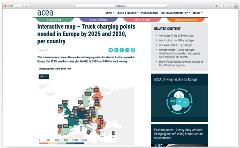ACEA (the European Automobile Manufacturers’ Association) has released a new interactive map that shows the number and location of hydrogen refuelling stations that will be required to meet the needs of fuel cell HGVs in the future. It says that binding targets should be set for each member state.
 The first hydrogen fuel‐cell electric vehicles are already being rolled out in Europe. From the mid‐2020s the vehicle offering will increase significantly, with at least 60,000 trucks expected to be in operation by 2030. This interactive map shows the number of truck-specific hydrogen refuelling stations required in Europe (the 27 EU member states plus the UK) by 2025 and 2030 for each country.
The first hydrogen fuel‐cell electric vehicles are already being rolled out in Europe. From the mid‐2020s the vehicle offering will increase significantly, with at least 60,000 trucks expected to be in operation by 2030. This interactive map shows the number of truck-specific hydrogen refuelling stations required in Europe (the 27 EU member states plus the UK) by 2025 and 2030 for each country.
However, the infrastructure that is indispensable to refuel these fuel-cell trucks is almost completely missing today. Because of their higher power and energy demand, heavy‐duty vehicles simply cannot use existing infrastructure for cars.
As the new ACEA position paper on truck infrastructure requirements explains, this issue must be addressed urgently. Policymakers need to take action to ensure a rapid infrastructure roll‐out as part of the review of the Alternative Fuels Infrastructure Directive (AFID).
ACEA says that an EU-wide target of around 300 truck‐suitable hydrogen refuelling stations by 2025, and at least 1,000 no later than 2030, should be set. Moreover, one hydrogen refuelling site should be available every 200 kilometres along the TEN‐T core network by 2030.
Photo: ACEA website.